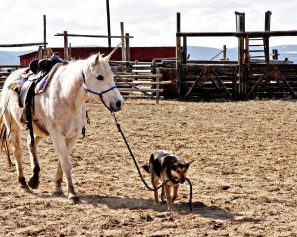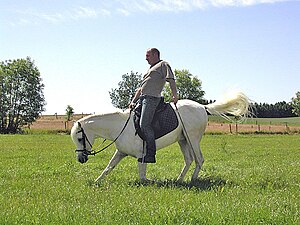 When teaching dogs new behaviors, we mostly focus on positive reinforcement, in other words, on adding something to the situation that will increase the chances of a particular behavior or aspect of a behavior to occur. Giving the dog a treat for sitting, lying down or looking at us is easy to do and understand, and is at the core of most modern dog training protocols. In horse training however, one of the main principles applied is the concept of yielding to pressure through the use of negative reinforcement. The horse is taught to react to the slightest pressure of the reins against his/her neck for instance. Dogs aren’t horses of course, but more dog trainers today are starting to understand how to also use negative reinforcement in more effective ways with dogs.
When teaching dogs new behaviors, we mostly focus on positive reinforcement, in other words, on adding something to the situation that will increase the chances of a particular behavior or aspect of a behavior to occur. Giving the dog a treat for sitting, lying down or looking at us is easy to do and understand, and is at the core of most modern dog training protocols. In horse training however, one of the main principles applied is the concept of yielding to pressure through the use of negative reinforcement. The horse is taught to react to the slightest pressure of the reins against his/her neck for instance. Dogs aren’t horses of course, but more dog trainers today are starting to understand how to also use negative reinforcement in more effective ways with dogs.
When we think of negative reinforcement, we’re referring to the removal of an aversive to reinforce, to strengthen or increase the occurrence of a behavior. In dog training, the ear pinch retrieve is an example of negative reinforcement. The trainer stops pinching the ear against the clasp of the leash as soon as the dog grabs a hold of the object. Once the dog understands how to avoid the pain, he/she will get quicker and better at biting onto the object. I’m not advocating the use of pain. We don’t need to use pain and discomfort to achieve high levels of training. Dogs don’t need to learn that we can be the source of such unpleasant experiences. Negative reinforcement, as a teaching strategy, isn’t the problem. The problem is how we use it. Negative reinforcement doesn’t have to be associated with pain and discomfort and can still be a very effective teaching tool, especially when used in conjunction with positive reinforcement.
Most of us are familiar with the notion of opposition reflex. First defined as the Freedom Reflex by Pavlov (1849-1936), the opposition reflex or Thigmotaxis is the response of an animal (or human) to physical contact. If someone leans on us or pushes us, we tend to push back. The same way, when we pull on a dog’s leash, the dog is likely to pull the other way, making the whole experience even more unpleasant. In horses, I don’t promote many of the training techniques that rely mostly on the application of positive punishment. Some training tools, however, are interesting to look into as they focus on teaching the horse to yield to pressure, not push against it. The slight pressure applied to certain areas on the body triggers the horse to move in certain directions. Apply a very light pressure of the rein on the left side of the neck and the horse will move towards the right, away from the pressure. Apply a very light pressure of the hand on the horses’ body and he/she will move away. This is important in riding but is also very useful when you need to move the horse around for care.
Yielding to pressure is a learned behavior, is very easy to teach and has multiple applications. First, you’ll need to define which body part you would like to move. With horses, if you want the horse to move backwards for instance, you’d place your hand on his/her chest and apply a light pressure, nothing painful or unpleasant. The horse may react by pushing back or do nothing. The trick here is to try to follow the animal’s movements in order to keep the pressure constant as long as he/he does anything other than a backward movement. As soon as the animal leans back or steps back, immediately release the pressure (the negative reinforcement part) and click and treat. After a few repetitions, a very slight pressure on the chest will trigger the horse to step back. The animals quickly learn when you’re asking them to move away from the light pressure or just petting them
In dogs, one of the behaviors that most pet parents struggle with is Loose Leash Walking (LLW). Pulling triggers more pulling, so the trick here is to teach the dog to yield to the pressure on the leash, not push against it. Grisha Stewart has great videos on what she called ‘silky leash’. The technique is very simple. In a very low distracting environment, apply a very slight pressure of the leash on the dog’s collar. In other words, pull very gently on the leash. As long as the dog is pulling away, accompany the movements and try to keep the pressure constant. As soon as the dog moves towards the pressure however, immediately release the pressure, click and treat. It makes it much easier to start in a small room, where the dog’s ability to move away from the pressure will be limited. We’re teaching the dog to respond to the slightest tug on the collar, so it’s important not to pull. After a few repetitions, the dog will start moving in the direction of the light tug and you may start guiding the dog on a very light leash for more and more steps. Just like any other behavior, it’s important to gradually increase the levels of difficulty and make sure that while working on this, the dog doesn’t have a chance to experience pulling. The use of a head halter or harness until the dog can be walked on a flat collar with a loose leash would be critical for the success of the training.
 Using the same principle, just like horses, you can teach a dog to move certain body parts. When working with my horse, I was wrapping a rope around her legs or her body to teach her to follow the pressure and generalize the concept. With dogs, it becomes easy to ask them to move to get them to move different body parts, when grooming them or caring for them at the vet. A more fun application of this technique is shown in freestyle competition. Michele Pouliot for instance, uses ropes the same way as done with horses, to teach her dog to move into certain positions by following the feel of the pressure. Just like horses, the dog can learn to move to the right to the feel of the rope on his/her left and can easily be taught to move backward, sideways, forwards, etc…
Using the same principle, just like horses, you can teach a dog to move certain body parts. When working with my horse, I was wrapping a rope around her legs or her body to teach her to follow the pressure and generalize the concept. With dogs, it becomes easy to ask them to move to get them to move different body parts, when grooming them or caring for them at the vet. A more fun application of this technique is shown in freestyle competition. Michele Pouliot for instance, uses ropes the same way as done with horses, to teach her dog to move into certain positions by following the feel of the pressure. Just like horses, the dog can learn to move to the right to the feel of the rope on his/her left and can easily be taught to move backward, sideways, forwards, etc…
Yielding to pressure is another teaching tool that can help jumpstart certain practical or fun behaviors with our dogs. We’re only at the beginning of it’s uses in dog training, but with more trainers understanding it’s applications we’re likely to see many more creative ways to train our dogs.
Jennifer Cattet, Ph.D.
Related articles





Super article! In the Pen Pals program, the inmate handlers teach this gentle, yielding to leash pressure exercise to the dogs to get them to the point that they’re responsive to very light pressure. 🙂
Excellent article!! This is such a powerful concept.
Great article. I like that horses and dogs were compared. Helps understand the topic at hand even better.
Of course, if we can use positive reinforcement to teach any of these skills, we should still do it. I’m hesitant to use tons of negative reinforcement if there’s a more positive alternative that works.
Great article. We (Two Bears Dog Training) have been using this technique for many years.
Great article! For certain dogs, these types of exercises can take the confusion and anxiety out of the leash (and handling). It does take skill and experience to apply and teach, though.
I use a lot of what I’ve learned about “light” hands from riding horses in my leash technique with my dogs. People are very surprised when the walk them how responsive they are to leash pressure. With my APBT mix, if she is excited on walks and tries to walk ahead of me, I’ll let her take the slack out of the leash and rock back on my heels; the pressure is VERY slight, but makes her bring her own weight back and slow down.. makes me think of it as a doggy half-halt 🙂
I also use a micro-version of BAT / silky leash that calms her down and prepares her to walk past things she can be reactive to, giving a “yes” and immediate slack in the leash whenever she looks away from the person/dog. It has helped her overcome most of her reactivity issues.
-R is definitely something that bears more looking into for trainers I believe, and can certainly be used without force or pain. Excellent article, Thanks!
Thank you for this article! I use negative reinforcement for teach leash manners in my dog training programs on a regular basis and it works wonders! I also use it for what I call “doggie decompression,” a process that induces a dog to calm down in a variety of scenarios. Really great article, thanks again!